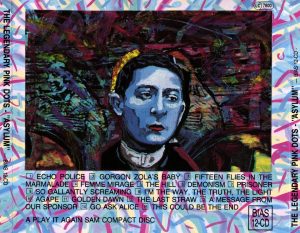Edward Ka-Spel’s brilliance with The Legendary Pink Dots is to introduce us to isolated characters and then immerse us in their world-view through expansive and mysterious soundscapes. He begins with the most restricted, infinitesimal point of consciousness and then slowly expands it outward towards a state of ‘cosmic consciousness’ (to use the phrase of 1960s psychonauts). Musically, he often follows this template of expansion, with simple melody lines repeating and layering in increased complexity of texture. Much of the LPD’s music is an undertaking to help the listener (and perhaps composer) escape his/her own head. Lyrical phrases, musical motifs, album titles and themes recur across decades, but tonal shifts between albums are slow and subtle. Hopefully, The Legendary Dots Project, like the Residents and Sparks projects before, will provide the keen reader and listener with a giddy entry-point into the Legendary Pink Dots’ musical world. Fulfil the prophecy!
For this month’s Legendary Pink Dots review we have a new contributor ~ long-time Dots fan, music guru and political animal, John Robinson!
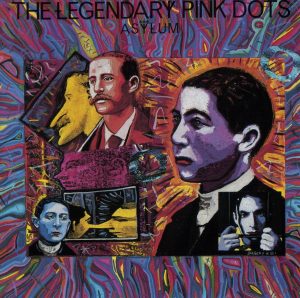
Tom: So, welcome to part 14 and year 5 of our ‘Project’; over the past 3 years and 3 months, we have expounded the best part of 35,000 words on what is still only a fraction of the LPD oeuvre. This couldn’t be the end, could it? Nah!
To venture into the Asylum, I am not so sure about ‘Echo Police’; it is Tower-style paranoia but we have already had The Tower and this doesn’t go anywhere new. Following this musical and lyrical re-tread, we have ‘Gorgon Zola’s Baby’, which does mark out new territory for the Dots: very 1980s Fairlight-style sounds – 1985 was also the year of Kate Bush’s Hounds of Love and its wondrous second-side sound suite. He rhymes “stale spaghetti” with “machete”, for the general amusement, as high-note slices of an Opera singer and a plodding bass line canter and then dissolve…
Ornate classical strings pirouette into view: ‘Fifteen Flies in the Marmalade’. Which, even more than ‘Gorgon Zola’s Baby’, marks out distinct terrain and has the choice interrogative and one-liner: “Will you dance with me, my little pickled herring?”
This is unmistakably Ka-Spel, and could be no-one else. His style is even more direct than Robyn Hitchcock, and that English songwriter’s amorous focus is for insects. You can’t really imagine him then developing it thus: “I love you with your fish-nets on…!” This is followed by some rather everyday laughter from EK-S. This is a becalmed, woozy music-hall singalong, not a million miles away from Vivian Stanshall – with EK-S’s higher vocals instead of Stanshall’s stentorian, deep tones. I know that once I mentioned Dan Treacy in relation to K-S, but that is more just the vocal pitch and accent; he surely has more of a lyrical and attitude affinity to (1970s-90s) Hitchcock and Stanshall, but is, of course, entirely his own force in music.
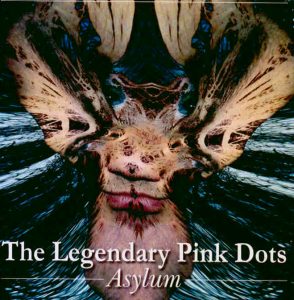
Again, we have different with ‘Femme Mirage’: a musically atypical slice of slow, drifting apartness. Vocally atypical, as lead sung by Julie Niblock. The lyrics connect to previous LPD songs about incommunicability and are clearly in tune with fashionable 1970s-80s academic theory. The following connects to post-structuralism and radical feminism: “The sticky threads that communicate the meaningless in a thousand different ways. My voice shuns your honey words on hour glass shapes. On the fragile, unreal, objects of desire.”
The kaleidoscope quality of this album continues, as ur-1980s keyboard foolery pervades ‘The Hill’. Its skittish musical form contrasts absurdly with the content: a Thomas Hamilton-style gunman killing children. The narrative concisely explains his apparent ‘insanity’ as due to psychological abuse by the people around him and outlines his move to the titular hill. His gunning down of the kids ensures that “No one laughs at Michael now!”
‘Prisoner’ is desperate, restless and, for me, a somewhat over-extended song. ‘So Gallantly Screaming’ is its corrective: the sort of epic that sees the LPDs traverse new, indeed giant steps. It resembles a vast, vast abandoned cruise liner in space and sounds like one of the long story-monologue songs I saw them do at the Star and Shadow Cinema in 2014 with John. It has outstanding imagery and soundscapes, like The Mekons’ ‘Ghosts of American Astronauts‘ crossed with The Beatles’ ‘Revolution No.9’. It contains more different sections than ‘Bohemian Rhapsody’ and a lot more implicit and explicit politics. “Well, we still have the songs – but where are you Gershwin, now that we need you? God, how we need you…”
There is the Zen-like calm of the repeating descending notes that recur time and again, played by different instruments – slight echoes of Gavin Bryars’ modern classical ‘Jesus’ Blood Never Failed Me Yet’. There is the paradoxically controlled-berserk nature of the editing and the weird electronic graffiti that is daubed all over. There is a masterly use of samples. There is the sense of maximalist lack of restraint and infinitely subtle detail: particularly suited to listening on a canny set of headphones.
It is, fundamentally, an immense lament and autopsy for the fallen American Dream, with Hendrix and Astaire all gone, all gone. God, how it earns and needs its 673 seconds. Oh, and there’s a mint YouTube video too.
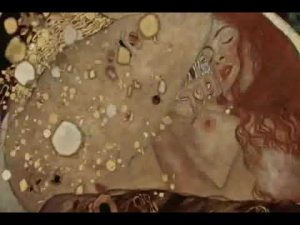
Back into more conventional waters with ‘I’m the Way, I’m the Truth, I’m the Light’, a third epic in a row, clocking in at 8 mins 1 second! Tis musically affable, fairly typical 1983-85 LPD fare, with a seasoned chord sequence and chugging, choppy violin. It is the tale of a “merciful angel” of a similar ilk to that in ‘Flowers for the Silverman’, but without quite the zest, killer chorus or level of detail.
After this somewhat wearying and busy piece, ‘Agape’ has a necessary balm-like quality, with Niblock’s exquisite vocals and a delicate, plaintive tune. There are vague classical allusions to “the sirens” and it is decidedly lovely. Next is the Tower-ish, arpeggiated synth grid of ‘Golden Dawn’, which continues the album’s improvement. It gets me thinking, of all things, of the BBC’s 1978-81 science-fiction drama series Blake’s Seven, which wrapped up as the Dots’ saga was commencing. This elegant, romantic avowal has a similar fatalistic tone, but evidently none of the wobbly sets or curt Avon rejoinders.
‘The Last Straw’? It isn’t, quite! Indeed it’s not a bad track, though doesn’t approach the impact of Robert Wyatt’s non-definitely articled 1974 track of similar naming. Where it does score is in the “Sores are creeping on his skin, there’s desperation in his eyes” section, which reminds me of ‘The Lovers (Part Two)’.
‘A Message from Our Sponsor’ seems, suitably, like it’ll be an instrumental. It is vaguely dystopian, with a God-like narrator entering the fray in the latter half. This is a pitched-down, vaguely “Satanic” vocal, no doubt EK-S’s voice manipulated. ‘Go Ask Alice’ is musically quite routine, but with backwards-vocals that evoke that long-time fad for playing songs backwards to reveal hidden messages. Amusingly enough, this one pokes fun at this cultural meme by having an innocuous conversation that includes such mock-revelatory sections as how Gregory Peck is “boring” and a “bastard”!
 The terminal ‘This Could Be the End’ really is. It is yet another epic which closes this strange, higgledy-piggledy album. It opens with an evocatively dank organ and expands upon the gloomy Eastern European ambience of so much of the LPDs’ 1984-85 work. It is like the canal-side horrors of Don’t Look Now (1973) being seen through the even bleaker eyes of spring 1985. The UK Miner’s Strike was over. In his heartening show The Red Shed, that I saw this August at the Traverse in Edinburgh, Mark Thomas willed us to believe in the veracity of his recollection that children in a schoolyard in a Yorkshire pit village sang “Solidarity Forever” as the miners returned to work and that this represented future hopes.
The terminal ‘This Could Be the End’ really is. It is yet another epic which closes this strange, higgledy-piggledy album. It opens with an evocatively dank organ and expands upon the gloomy Eastern European ambience of so much of the LPDs’ 1984-85 work. It is like the canal-side horrors of Don’t Look Now (1973) being seen through the even bleaker eyes of spring 1985. The UK Miner’s Strike was over. In his heartening show The Red Shed, that I saw this August at the Traverse in Edinburgh, Mark Thomas willed us to believe in the veracity of his recollection that children in a schoolyard in a Yorkshire pit village sang “Solidarity Forever” as the miners returned to work and that this represented future hopes.
Its opening includes a sound at its start which could be of a working pit. While it is all rather subtle and veiled, with horror film shrieks and references to trapdoors and a masked man, there is little doubt as to the signified behind these signifier words: “YOUR PAIN IS FOR YOU ALONE, AS IT IS, AS IT WAS, AS IT WILL BE. FOREVER. AMEN.”
There is grotesque stuck-record laughter, as apt in our GB16 as in David Peace’s GB85.
The vocoder fades, and the lines are sung in a way which sees the LPDs getting closer to the territory of Henry Cow, This Heat and The Camberwell Now than before, with deadpan, Brechtian harmony vocals repeatedly intoning:
“YOUR PAIN IS FOR YOU ALONE, AS IT IS, AS IT WAS, AS IT WILL BE. FOREVER. AMEN.”
So, Asylum. This is not one that sustains itself in the mind as a cohesive album, but is yet another LPDs release with some absolutely breath-taking music on it. Furthermore, it forms a stepping stone from 1985 to the socially atomised decades of the neo-liberal consensus that followed.
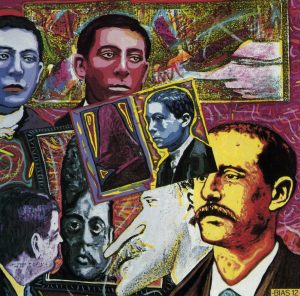

Adam: The Legendary Pink Dots’ Asylum is a curate’s egg. It is a lumpy, blue-veined, sometimes pungent egg, but an egg nonetheless. The album was produced with the band in complete disarray. Edward had retreated from the Netherlands following The Lovers (1984) and, as a result, the band no longer had access to the multi-track recorder they used at The Melkweg show nor the studio space in Hilversum, which together gave the ’84 album its sharp, expansive sound. By contrast, Asylum was recorded in Patrick Wright‘s bedroom. As a result, the album sounds intimate on headphones; cramped and almost taciturn on a stereo system. It is as though the louder you try to make the album, the more it seems to retreat from you. It is a thing illuminated in dark spaces. Of course, since Asylum is a semi-congealed-patchwork-concept-album-sort-of-a-thing addressing mental illness and confinement, it is thematically apposite that the experience of listening to it should be claustrophobic and reward isolated introspection. However, it also makes of the album a prickly, prickly, prickly pear indeed. Curiously, it also seems to be one of the Dots’ best known releases and one especially beloved by fans!
One reason for this might be because an album as obtuse as Asylum necessarily hides its secrets and, as such, repays re-listening. Asylum features backwards-tracked vocals, numerology, hints of shadowy behind-the-scenes personnel (a la The Residents‘ relatively benign ‘Cryptic Corporation’ or Cardiacs‘ more sinister ‘Alphabet Business Concern’), in-jokes, obscure lyrics which seem tantalizingly rich with meaning, references to other songs from the band’s back catalogue (okay, to be fair, this is a given for the Dots) and guest contributions, in this case from Attrition‘s Julia Niblock Waller. It is also very long – just over an hour-and-a-quarter. I have read in other reviews that Asylum is a poor choice of album for those listening to the Dots for the first time. I agree that it’s an album that if forced upon the listener by an enthusiastic friend is likely to be met with bemusement or dismissal on account of the unlikelihood that the initiate listening for the first time

is going to have an experience that whatsoever aligns with that of the fan listening for the seventeen time. However, because it is – out of all their 1980s output – the album for which the Dots are known (though I suspect that their 1990s output is better known in general) I suspect that it is often the album that the intrepid collector and/or explorer of psychedelic and alternative music arrives at when they first discover the band. And as with Picky Picnic‘s Picnic Land (1982), The Residents’ Eskimo (1979) or even Captain Beefheart’s Trout Mask Replica (1969) (if it is possible to encounter that album before its reputation) the sheer unpalatability of the experience is likely to be its biggest draw. The unprepared, undirected listener will think: “What on earth is this? Who on earth made this? And what else have they made?” – likely in that order. An album like The Tower (1984) because it is a more cohesive, more explicable, more sensible album (in both senses of that word) is unlikely to elicit the same thrill of discovery. Likewise, I think Picky Picnic’s Ha! Ha! Tarachine (1985), The Residents’ God in Three Persons (1988) and Captain Beefheart’s The Spotlight Kid (1972) are all more fully-realised pieces of work than the aforementioned albums, but they are unlikely to furnish quite the same thrill of discovery.
The first track on Asylum is the mordantly stirring ‘Echo Police’. To me ‘Echo Police’ sounds like the title of a 1960s/ 1970s dystopian sci-fi novel, in the vein of Harlan Ellison’s ’65 Galaxy Science Fiction short story ”Repent, Harlequin!’ Said the Ticktockman‘ or Philip K. Dick’s ’74 novel Flow My Tears, the Policeman Said. I tried drawing what I imagined a member of the Echo Police to look like. They ended up having a bi-concave body on stilts with an infinitely recessing vaginal opening in their stomach, like a person from Andrew Thomas Huang’s Solipsist (2012) crossed with a creature from Kikiyama’s RPG Maker game Yume Nikki (aka Dream Diary). The drawing probably said more about my internal psychology than Ka-Spel’s since, in fact, the song’s lyrics do not provide much information about the titular figures themselves. In his review of the album, Michael Rodham Heaps beautifully describes Edward in his role as chief lyricist and vocalist on Asylum as: “spinning reason a merry dance, splashing ’round in the puddles of your mind, scenery weaving with that usual slow zeal, banana peeling the plexiglass between your mind and his.” Sensations of characters and places form in the listener’s mind in half-illuminated fragments with everything kept just slightly out-of-focus.
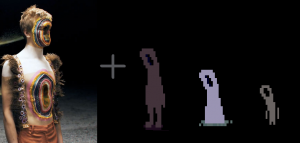
According to Edward’s lyrics, the Echo Police “shoot twice and ask you zero-zero questions”. Just as in ‘Tower One’ where “no-one names a crime committed, no-one blames a soul”, the Echo Police work upon the presumption of guilt as a metaphysical given. It is not that they are cruel per se, but that they exist beyond the concept of mercy. In such a society all citizens are like the protagonist of Albert Camus’ The Fall (1956), assured of their own existential guilt, which can only ever be echoed back at them as they seek and assert the guilt of others. It is the bleakly (il-)logical endpoint of the political truism that “when you’ve got nothing to hide, you’ve got nothing to fear”. If the concept of privacy itself is suspect (i.e. it’s not that the citizen is hiding anything illicit in particular, but the fact that by virtue of being a private citizen they are – by definition – always already hidden) then all citizens have something to fear when they hear the midnight knock upon the door. The lyrics describe how the Echo Police print out messages of “overload in code”. They seem to be robotic – automaton instruments of the state. How could such machines possibly process the complex vacillations between human culpability and mitigating circumstance? Like interrogators who work from the zero-level assumption that the suspect is holding something back (no matter if that something is really nothing), the Echo Police appear to me as the steely embodiment of a quote from another, different Philip K. Dick book, A Scanner Darkly (1977): “Does a passive infrared scanner […] see into me – into us – clearly or darkly? I hope it does, he thought, see clearly, because I can’t any longer these days see into myself. I see only murk. Murk outside; murk inside. I hope, for everyone’s sake, the scanners do better. Because, he thought, if the scanner sees only darkly, the way I myself do, then we are cursed, cursed again and like we have been continually, and we’ll wind up dead this way, knowing very little and getting that little fragment wrong too.”
Appropriate to its sci-fi lyrical stylings, ‘Echo Police’ sounds 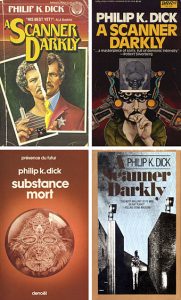 like it’s been lifted from the soundtrack of a slightly ropey John Carpenter film. The synths have a flat, thudding quality and the drum machine sounds tired, but then this industrial dirge is lifted by glittering arpeggios and given forward propulsion by a weirdly funky piece of violin playing and the dystopia opens out before the listener. Asylum has lots of little blind-siding tricks like this, setting off the majestic against the banal. Indeed, it is often in the transitions within songs – the bridges and the interludes – that I find the album most arresting. For instance, the moment [at 01:15] in which ‘Demonism’ abruptly lurches from violin-driven chamber music from Hell to a staccato assault of post-punk keyboard and guitar. It is like a drunken wedding party violently invaded by the foreign legion. Or, in the following song ‘Prisoner’, when that same staccato rhythm keeps advancing rat-a-tap-tap only to be cut off at 4:16 by a warm wash of ambient noise that sounds remarkably like it’s been taken from Matmos‘ The Civil War (2003) only if that album had been released two decades earlier.
like it’s been lifted from the soundtrack of a slightly ropey John Carpenter film. The synths have a flat, thudding quality and the drum machine sounds tired, but then this industrial dirge is lifted by glittering arpeggios and given forward propulsion by a weirdly funky piece of violin playing and the dystopia opens out before the listener. Asylum has lots of little blind-siding tricks like this, setting off the majestic against the banal. Indeed, it is often in the transitions within songs – the bridges and the interludes – that I find the album most arresting. For instance, the moment [at 01:15] in which ‘Demonism’ abruptly lurches from violin-driven chamber music from Hell to a staccato assault of post-punk keyboard and guitar. It is like a drunken wedding party violently invaded by the foreign legion. Or, in the following song ‘Prisoner’, when that same staccato rhythm keeps advancing rat-a-tap-tap only to be cut off at 4:16 by a warm wash of ambient noise that sounds remarkably like it’s been taken from Matmos‘ The Civil War (2003) only if that album had been released two decades earlier.
But we’re getting ahead of ourselves. On the Dots’ bandcamp page not only are ‘Demonism’ and ‘Prisoner’ united as one track, so are tracks two and three, ‘Gorgon Zola’s Baby’ and ‘Fifteen Flies in the Marmalade’. The latter is a sickly trifle, a mock baroque piece of warbling chamber music. The song’s narrator sounds like a syphilitic bon-vivant, left to rot at a table laden with fly-spotted marmalade, the crumbs of eaten bread and a pickled herring in fishnets with which the narrator wishes to dance. The persistent electronic buzzing of flies pervades the song with an air of filth and decay. It is like a more queasily “off” take on Sparks‘ curious ‘Under the Table with Her‘ (1975).
‘Gorgon Zola’s Baby’, meanwhile, is festering glitch-funk with obscenely squelchy keyboard noises and fragmented snatches of operatic warblings interposed to make the stew extra thick and greasy. It sounds pretty diabolical, but then again so does the song’s titular figure. Gorgon Zola (which I will admit to being a pretty tasty pun!) is “tall and cruel and cool as sour cream”. The lyrics’ nursery rhyme aesthetic, with simple c ouplets of assonant/ sibilant monosyllables set to dissonant a-rhythmic beats, immediately conjures memories of songs from The Residents‘ Duck Stab!/ Buster & Glen (1978). Perhaps Gorgon Zola attended the same finishing school as the Residents’ ‘Lizard Lady’, who “crawls and counts her cans and twitches like a flea”; or the same album’s ‘Semolina’, who can “see the silver sometimes shining on the sea”.
ouplets of assonant/ sibilant monosyllables set to dissonant a-rhythmic beats, immediately conjures memories of songs from The Residents‘ Duck Stab!/ Buster & Glen (1978). Perhaps Gorgon Zola attended the same finishing school as the Residents’ ‘Lizard Lady’, who “crawls and counts her cans and twitches like a flea”; or the same album’s ‘Semolina’, who can “see the silver sometimes shining on the sea”.
Indeed, Asylum is easily the most Residential of the Dots’ albums. It has the same sense of childish depravity poised on a knife-edge between cutely whimsical and genuinely unnerving. It almost seems as though during the writing of Asylum the Dots were subscribing to the ‘Theory of Phonetic Organization’ devised by The Residents’ anonymous guru N. Senada. According to this theory, songs should be built up from the sounds themselves, rather than from the classically traditional elements of rhythm/ tone/ structure etc. That is to say, in some of the tracks on Asylum there is not a whole lot of rhythm, melody or even harmony going on.
In ‘Femme Mirage’, for instance, the sounds seem unanchored to any recognisable structure, appearing out of the auditory abyss only to disappear again seconds later into the darkness. The effect is somewhat similar to what Scott Walker achieved on his disconsolate trilogy of Tilt (1995), The Drift (2006) and Bish Bosch (2012). However, Walker has always had an incredible voice which, though weakened with age, retains a terrible gravity. ‘Femme Mirage’ is sung by Julie Niblock of the band Attrition. Her voice is suitably spooky here, but also somewhat reedy – not strong enough to make the song as dreamily hypnotic as one senses it was intended to be. Interestingly, the lyrics of ‘Femme Mirage’ seem to have been written by Niblock herself and are more wispily abstract and less viscerally affecting than Ka-Spel’s – less like the words of a sleep-deprived street preacher who has been reading too much J.G. Ballard and more like the poetry of a spectral dead Keats. Niblock’s lyrics for ‘Agape’ appeal to me more, though they are still rather nebulous and airy. But I like the intensity of the romantic sentiment evoked and the image of two lovers dancing in the surf together, oblivious to all others, which potentially ties the relationship to the one in the Ka-Spel penned ‘Golden Dawn’, in which the song’s couple fly to a secret island no-one else can find, where they lay together watching ‘the tide slide in at twilight’. Musically ‘Agape’ sounds like three Brian Eno tracks played simultaneously. It is lulling, but a little vertiginous. Adam Curtis should use it in a documentary. Julie Niblock must have been close to the band around this period since the Dots joined with Attrition in 1985 to release the joint cassette The Terminal Kaleidoscope, which features the previously reviewed songs ‘Flowers For The Silverman’, ‘A Lust For Powder’, ‘Kitto’, ‘Tower 4’ and ‘Neon Gladiators’ – a pretty eclectic mix of the Dots’ output from the period.
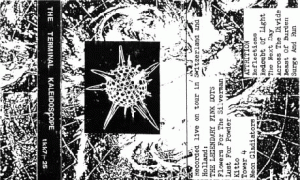
‘The Hill’ is one of the most conventionally structured tracks on Asylum and is, I believe, the L.P.D. track I have listened to the most times in my life. It’s not so much that ‘The Hill’ is my favourite song by the band, but rather, its catchy melody, 4/4 time and clearly-enunciated lyrics make it both immediately gratifying and easy to sing along to. Moreover, it’s antiquated keyboard patches possess a goofy charm. Musically the song wouldn’t be out-of-place in an episode of Pee-wee’s Playhouse, a show for which The Residents provided music. The guitar licks on the track also recall the strangled, but buoyant playing of regular Residents collaborator Philip “Snakefinger” Lithman. In short, the music is a whole bunch of zany fun! However, the lyrics are about a mass shooter, which should put a dampener on things – although it doesn’t really since the vocal delivery of Ka-Spel and Patrick Wright is worryingly gleeful! As Syd Barrett had sympathy for underwear-snatcher Arnold Layne, the Dots have sympathy for… um… child-murdering Michael. The Dots are nothing if not dedicated in their commitment to the bullied and the marginalised, however deviant or criminal! Indeed, Michael might be the ghoulish flip-side to the persecuted ‘Frosty‘, who avoided bullies by locking himself away in a refrigerator. Meanwhile Michael, who doesn’t understand why people warmly take him by the hand and then mock him behind his back, chooses a strong offence as the best defence. Although I suspect that the Dots are not taking themselves so very seriously on ‘The Hill’ it is salient to note that Asylum also provides sympathetic portraits of of an incarcerated man in ‘Demonism/ Prisoner’ and of a condemned man facing capital punishment in ‘This Could Be The End’. I suspect that, however deplorable an individual’s actions, Ka-Spel has the anarchist sensibilities to always champion the individual at the expense of the state. The abuses the private citizen (who has often been abused and victimised him/herself) is able to commit pale in comparison to the sanctified abuses committed by the fascistic or autocratic state. I am reminded of Camus’ eloquent argument against the death penalty in ‘Reflections on the Guillotine‘ – that while a man may kill in a moment of heated passion, the state will coldly and calculatedly lock him away from decades, sentencing him to thousands of hours of a living death before executing him in cold blood – a cruelly disproportionate response that refuses to admit the “solidarity of all men in error and aberration”.
After the woozy carnival waltz of ‘The Hill’ we have the decidedly less madcap ‘Demonism’ and ‘Prisoner’. The former sounds like an interlude by Shostakovich performed in a room with an over-heating electroconductor. The latter is an intense and skittish medley of insistent bass guitar and keys on an anxiety-inducing loop. This pair of songs is followed by the assured epic ‘So Gallantly Screaming’, lamenting the loss of American innocence post-Vietnam and Nixon as though through the mind of a traumatised soldier a la Adrian Lyne‘s Jacob’s Ladder (1990). It starts with Patrick Wight’s ever-present violin ascending slowly to a sickening pitch. Then a rumbling, resonant soundscape drifts into view like a gray mist. After Ka-Spel intones sinisterly about a hospital where “the doctor’s demented and holding a pin”, where if the patients “cry out, he’ll hammer it in”, terrifying thuds as though a television’s being hammered slice up a staccato series of sound samples – screams and blips and glitches and machine-guns and helicopter blades and cartoon sound effects. When I first listened to the track on headphones on a bus ride home in the dark I was very scared. Yet, the tone of the song is as mournful as it is sinister. A curious motif in the lyrics is of Edward appealing to American composer George Gershwin (“where are you Gershwin?” “where are you George?” “God how I need you right now”) like a saint or a spirit who might come and make American pure and sweet and good again. Coincidentally, Asylum was released just a year after the Residents’ George & James album, which re-works material by Gershwin alongside songs from James Brown’s 1963 Live at the Apollo. However, the sad organ refrains that echo through the dismal soundscape of ‘So Gallantly Screaming’ – like the Fats Waller tunes that echo sadly through Alan Splet’s sound design for David Lynch’s Eraserhead (1977) – bear a far cannier resemblance to music from another album in the Residents’ abortive “American Composers” project, Stars & Hank Forever from 1986, particularly the John Philip Sousa marches from that album.

The following track on the album is another mini-epic, ‘I’m the Way, the Truth, and the Light’, which rather pales in comparison next to ‘Gallantly Screaming’. Perhaps it was a mistake to place two songs both roughly ten minutes in length next to each other in running order. Either way, in transferring Asylum onto the dictaphone on which I listen to my MP3s I forgot to copy over ‘ItWtTatL’ and didn’t realise until the fifth time of listening to the album through, so it clearly didn’t make a great impression on me! Wright’s violin provides the bulk of the heavy-lifting here, but remains a little static until the two-minute mark. I very much like that the lyrics could either be from the point-of-view of a man who delusionally believes himself to be Jesus or from a vengeful reincarnation of the Lord who can genuinely make good upon his threats! However, the premise is stretched a little thin, despite some nice vocal work from Edward.
‘Golden Dawn’ is a flat-out gorgeous piece-of-work that reminds me a little of the far earlier ‘Voices‘. It’s really the pinnacle of the classic Dots template. Whistling synths; keyboard playing a teasingly sinister arpeggio; moaning guitar; plaintive but insinuating vocals. It’s like a reprise, or even a swan-song, for the 1981-1984 incarnation of the Dots. As such, I suspect it might have been recorded a little earlier than the Asylum sessions, possibly in Amsterdam. It’s an eerie, romantic gem and rather more charming than the following track ‘The Final Straw’. ‘Final Straw’ starts weary and leaden and surprisingly like R.E.M.’s ‘Feeling Gravity’s Pull’ from the gloomy but enticing Fables of the Reconstruction, released the same year as Asylum. The intro resolves itself into a bizarre Transylvanian folk waltz thing… though I must admit to not being entirely sure why as this only lasts for less than twenty seconds! The lyrics are about the dying days of a junkie, territory previously visited by the Dots with ‘Soma Bath’ from Brighter Now (1982). It does nae do much for me.
I’m rather fond of ‘A Message From Our Sponsor’ though, which begins with the sound of an overhead chopper, which inevitably puts me in mind of both Apocalypse Now (1979) and the beginning of ‘The Happiest Days of Our Lives’ from Pink Floyd’s The Wall (1979), even though I’m not actually sure that the sound effect there is actually meant to be a helicopter. Earlier I fluffed the truth a little when I said that Asylum hints at shadowy behind-the-scenes personnel managing the band. I first got that impression from the title ‘A Message From Our Sponsor’, but on listening to the lyrics came to the conclusion that the narrator of the song is, in fact, God, the “Sponsor” of humanity. It seems metal as hell to me for Ka-Spel to write a song from the point-of-view of God, especially on the same album as a song from the point-of-view of a pretend Jesus. Edward’s voice is modulated so that God speaks in a menacing low pitch, despite his reassurances that humanity should “feel easy” since he is “reasonable” and will “never interfere… no matter what you do”. Considering humanity’s tendency to fuck things up one is left desperately wondering if it wouldn’t be best if God would interfere sometimes to curb our worse impulses.
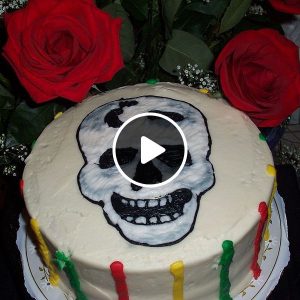
‘A Message From Our Sponsor’ ends with the chilling rejoinder to “SING WHILE YOU MAY!” since this “may not be for long”. This would segue appropriately into the album’s final track ‘This Could Be the End’, a meditation on death. However, before that, we have the backwards-tracked tomfoolery of ‘Go Ask Alice’. It’s really just some guitar noodling to a basic sequence played repeatedly on the keyboard. A trifle, but an entertaining one once you de-code the backwards vocals. ‘This Could Be the End’ is rather more impressive, beginning with the churning sound of some great mechanism of grumbling wood… perhaps a waterwheel with giant heaving paddles once the splosh of water is introduced into the mix, along with some warbling drones and the strains of Wight’s violin. Musically the tone is everso portentous, but I believe the Dots wholly carry it off. Personally I find the track so atmospheric I chose to use to create an impressionistic backdrop to a monologue from the ferryman Charon in the episode of my radio show ‘Sweet Dreams with Adam Whybray’ that gave voice to the stories of the dead (skip to 1:42:00 if you want to hear its inclusion). The track contains some wonderful “deranged clown jack-in-the-box” laughter and haunting, resonant and ghoulishly grim lyrics detailing a decapitation. It’s like Edgar Allan Poe’s macabre and darkly funny story ‘A Predicament‘ (1838) but without the disappointing racism. Indeed, the song provides one of my favourite lyrics from Ka-Spel, devastating in their simplicity: “Your pain is for you alone. As it is. As it was. As it will be.” It’s not funny because it’s true.
So, Asylum. A messy, ambitious, ludicrous grab-bag of an album. It may not always sate you, but it’s there when things get dark and you need a stinky little crawl-space to call your own.
John: Asylum….a place of refuge or a home for the insane?
The year is 1985 and it’s been a tough time for the Pink Dots leading up to this release; with nightmare gigs, exploding tour vans, vanishing road managers (and disappearing takings). Fittingly, the new LP (a double), is titled Asylum. But who is inmate and who the warder? The lines are blurred, nothing is certain anymore; this is the sound of a band fighting for survival and for its sanity.
It’s never easy writing about music, easier to just listen and let it happen, and with many records produced in the 1980s we are doubly challenged. The shiny synthetic instruments of the time haven’t travelled quite so well into the future they foretold, and so for first time listeners to this epic landscape of the mind I advise to take your time. Let your ears adjust to the production values of another era and let the music rise to the surface. For music there is, and in abundance.
Asylum is an ‘album’ in the true sense of the word. It’s an expansive collection of images, stories, characters, colours, and moods. It’s an exploration of the reality of reality (or madness if you prefer), and the sleeve artwork reflects this, with multiple faces, reflected in mirrors, distorted and twisted into grotesques asking yet again which is reflection, which is real, and which is the more interesting? Of the painted faces it’s telling that the only one to stare back at the listener is a prisoner behind bars.
And so onto the tracks….
The Echo Police – This sounds a little like a left over from an earlier Pink Dots, simple in arrangement but it’s the starting point. Who are they? Some Orwellian force, policing society, (policing minds?). They show no mercy they just don’t know how…
Gorgon Zola’s Baby/ Fifteen Flies in the Marmalade – And so the gallery of grotesques begins with ‘Gorgon’ Zola. The first in a series of sadistic women (or is it just the one?) on this album. The imagery of nurse and patient reappears later. Meanwhile somewhere in a particularly polite party Ka Spel offers to dance the light fantastic with someone he refers to as his ‘little pickled herring’ to the accompaniment of strings and the buzzing of flies. The strangeness starts here.
Femme Mirage – A vision of life through somnambulist eyes.
The Hill – A more conventional ‘song’; at least in structure, it echoes Bowie’s Man Who Sold the World lp, (another album that explores the fragility of minds). It tells the tale of poor Michael who no one listened to, but now he has a gun no one is laughing now. It ends with the full stop of suicide.
Demonism/ Prisoner – The sound of panic, a body convulsing, a foaming fit stuck in a lift. This is the moment madness fully takes hold and it’s downhill from here. Assuming the lift stops RISING!
So Gallantly Screaming – A sonic collage: Bladerunner through the eyes of Fred Astaire, steaming neon subways at night, nuclear war, racing minds, a new sense of time, no time, post time, old times gone and golden, moments of stillness, dreamlike trance, virtual reality, channel hopping as a way of life, and what is life anyway…where are you Mr Gershwin, now that we need you? The tape editing skills of Steve (Nurse with Wound) Stapleton come to the fore here, creating a truly immersive soundscape.
I am the Way, the Truth, the Light – At last, the calm after the storm. The intro hints at a sense of direction? A possible solution? No. Yet again madness reigns with this story of a restrained, medicated man in a dungeon of plastic in a castle of ice. A nurse’s needle the only escape, medicating his mind to still the screaming. The track ends with the screaming of an audience. Who is mad? Artist or audience? What is the reality of fame?
Agape – Finally… something soothing. Soft arpeggios and a female vocal. A song of love? Or the song of the Siren? Seemingly safe on the surface there is an undercurrent to this, under the surf, under the sea. It draws you in, comforts and yet there is a depth leading to death in the deep green sea.
Golden Dawn – Possibly my favourite Pink Dots song, but I often wonder if it actually belongs on this album. The production work sounds more polished perhaps, and the song is of another time, another mood. A song of adoration, worship, devotion to a love beyond the mundane. A love extraordinary. A (femme) mirage fever. Though in retrospect perhaps this is where a person arrives once the Sirens of Agape have done their work. Lost in the world of Golden Dawn and a slave to the Priestess… More arpeggios, but this time not so soothing, more like a structure, a spider’s web, a cage…with threads that shine and glisten…
The Last Straw – The rot has finally set in and the madness has done its work. Drugs are not enough, the flesh is weak. This journey into the prison of the mind has reached terminus. Join the dance, listen to the violin as we whirl endlessly and fall in a final exhausted flourish of existence.
A Message from Our Sponsor – This sounds like something from an 80s John Carpenter film. It’s cinematic in scope and again hints at something unnerving, and something of the dark possibility of mutually assured destruction lingers in its synthesizer patches. It ends with a distorted voice from another dimension declaiming/warning: SO SING! SING WHILE YOU MAY! (It may not be very long…)
Go Ask Alice – The prologue. This feels like the end of some strange late night/early morning tv show, the graveyard shift, a backwards conversation, a video recording of life rewinding to start its moebius loop of madness all over again next week, same time, same channel!
This Could Be the End – Charon the boatman pulls ashore to the sound of pipe organ there is no more. It’s over. This really is it. The final march of the dead. Together we sing in recognition: YOUR PAIN IS FOR YOU ALONE, AS IT IS, AS IT WAS, AS IT WILL BE. FOREVER. AMEN.
And that’s that. Only it’s not:
My Baby Likes to Hurt Me (BONUS TRACK) – Another cinematic song of destructive/sadistic love.
As you can see, it’s not easy to write about the Pink Dots in ordinary terms. Their songs are more than just words, they’re immersive worlds, with enough space for the listener to bring their experiences and perceptions along for the ride. They evoke, they inspire, they amuse and yes, you can sing along too if you want. For are we all not in the asylum?
So… Sing while you may! (It may not be very long…)
